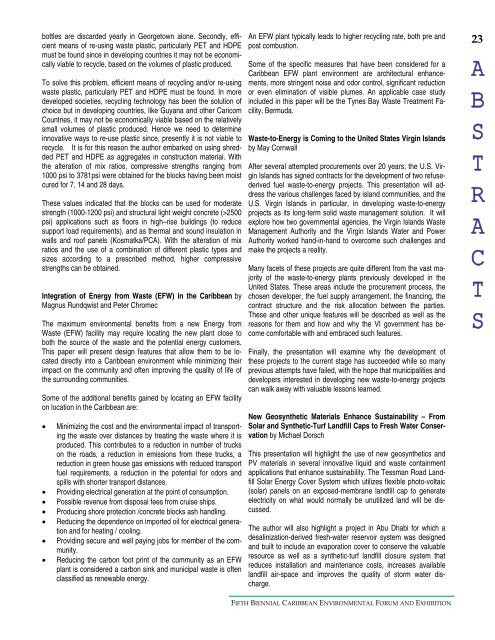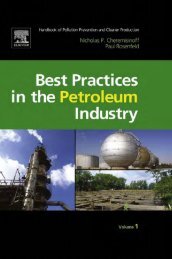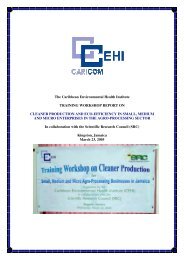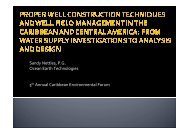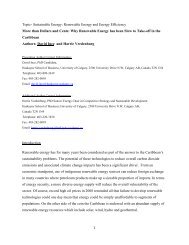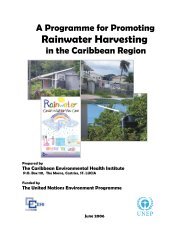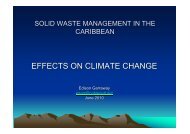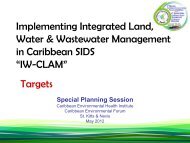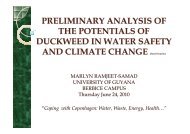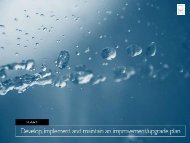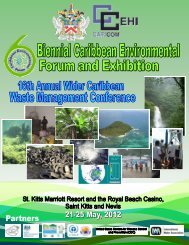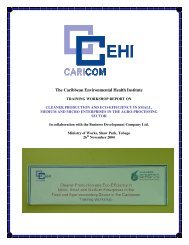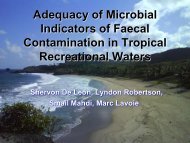conference magazine - Caribbean Environmental Health Institute
conference magazine - Caribbean Environmental Health Institute
conference magazine - Caribbean Environmental Health Institute
Create successful ePaper yourself
Turn your PDF publications into a flip-book with our unique Google optimized e-Paper software.
ottles are discarded yearly in Georgetown alone. Secondly, efficient<br />
means of re-using waste plastic, particularly PET and HDPE<br />
must be found since in developing countries it may not be economically<br />
viable to recycle, based on the volumes of plastic produced.<br />
To solve this problem, efficient means of recycling and/or re-using<br />
waste plastic, particularly PET and HDPE must be found. In more<br />
developed societies, recycling technology has been the solution of<br />
choice but in developing countries, like Guyana and other Caricom<br />
Countries, it may not be economically viable based on the relatively<br />
small volumes of plastic produced. Hence we need to determine<br />
innovative ways to re-use plastic since, presently it is not viable to<br />
recycle. It is for this reason the author embarked on using shredded<br />
PET and HDPE as aggregates in construction material. With<br />
the alteration of mix ratios, compressive strengths ranging from<br />
1000 psi to 3781psi were obtained for the blocks having been moist<br />
cured for 7, 14 and 28 days.<br />
These values indicated that the blocks can be used for moderate<br />
strength (1000-1200 psi) and structural light weight concrete (>2500<br />
psi) applications such as floors in high–rise buildings (to reduce<br />
support load requirements), and as thermal and sound insulation in<br />
walls and roof panels (Kosmatka/PCA). With the alteration of mix<br />
ratios and the use of a combination of different plastic types and<br />
sizes according to a prescribed method, higher compressive<br />
strengths can be obtained.<br />
Integration of Energy from Waste (EFW) in the <strong>Caribbean</strong> by<br />
Magnus Rundqwist and Peter Chromec<br />
The maximum environmental benefits from a new Energy from<br />
Waste (EFW) facility may require locating the new plant close to<br />
both the source of the waste and the potential energy customers.<br />
This paper will present design features that allow them to be located<br />
directly into a <strong>Caribbean</strong> environment while minimizing their<br />
impact on the community and often improving the quality of life of<br />
the surrounding communities.<br />
Some of the additional benefits gained by locating an EFW facility<br />
on location in the <strong>Caribbean</strong> are:<br />
• Minimizing the cost and the environmental impact of transporting<br />
the waste over distances by treating the waste where it is<br />
produced. This contributes to a reduction in number of trucks<br />
on the roads, a reduction in emissions from these trucks, a<br />
reduction in green house gas emissions with reduced transport<br />
fuel requirements, a reduction in the potential for odors and<br />
spills with shorter transport distances.<br />
• Providing electrical generation at the point of consumption.<br />
• Possible revenue from disposal fees from cruise ships.<br />
• Producing shore protection /concrete blocks ash handling.<br />
• Reducing the dependence on imported oil for electrical generation<br />
and for heating / cooling.<br />
• Providing secure and well paying jobs for member of the community.<br />
• Reducing the carbon foot print of the community as an EFW<br />
plant is considered a carbon sink and municipal waste is often<br />
classified as renewable energy.<br />
An EFW plant typically leads to higher recycling rate, both pre and<br />
post combustion.<br />
Some of the specific measures that have been considered for a<br />
<strong>Caribbean</strong> EFW plant environment are architectural enhancements,<br />
more stringent noise and odor control, significant reduction<br />
or even elimination of visible plumes. An applicable case study<br />
included in this paper will be the Tynes Bay Waste Treatment Facility,<br />
Bermuda.<br />
Waste-to-Energy is Coming to the United States Virgin Islands<br />
by May Cornwall<br />
After several attempted procurements over 20 years, the U.S. Virgin<br />
Islands has signed contracts for the development of two refusederived<br />
fuel waste-to-energy projects. This presentation will address<br />
the various challenges faced by island communities, and the<br />
U.S. Virgin Islands in particular, in developing waste-to-energy<br />
projects as its long-term solid waste management solution. It will<br />
explore how two governmental agencies, the Virgin Islands Waste<br />
Management Authority and the Virgin Islands Water and Power<br />
Authority worked hand-in-hand to overcome such challenges and<br />
make the projects a reality.<br />
Many facets of these projects are quite different from the vast majority<br />
of the waste-to-energy plants previously developed in the<br />
United States. These areas include the procurement process, the<br />
chosen developer, the fuel supply arrangement, the financing, the<br />
contract structure and the risk allocation between the parties.<br />
These and other unique features will be described as well as the<br />
reasons for them and how and why the VI government has become<br />
comfortable with and embraced such features.<br />
Finally, the presentation will examine why the development of<br />
these projects to the current stage has succeeded while so many<br />
previous attempts have failed, with the hope that municipalities and<br />
developers interested in developing new waste-to-energy projects<br />
can walk away with valuable lessons learned.<br />
New Geosynthetic Materials Enhance Sustainability – From<br />
Solar and Synthetic-Turf Landfill Caps to Fresh Water Conservation<br />
by Michael Dorsch<br />
This presentation will highlight the use of new geosynthetics and<br />
PV materials in several innovative liquid and waste containment<br />
applications that enhance sustainability. The Tessman Road Landfill<br />
Solar Energy Cover System which utilizes flexible photo-voltaic<br />
(solar) panels on an exposed-membrane landfill cap to generate<br />
electricity on what would normally be unutilized land will be discussed.<br />
The author will also highlight a project in Abu Dhabi for which a<br />
desalinization-derived fresh-water reservoir system was designed<br />
and built to include an evaporation cover to conserve the valuable<br />
resource as well as a synthetic-turf landfill closure system that<br />
reduces installation and maintenance costs, increases available<br />
landfill air-space and improves the quality of storm water discharge.<br />
23<br />
A<br />
B<br />
S<br />
T<br />
R<br />
A<br />
C<br />
T<br />
S<br />
FIFTH BIENNIAL CARIBBEAN ENVIRONMENTAL FORUM AND EXHIBITION


